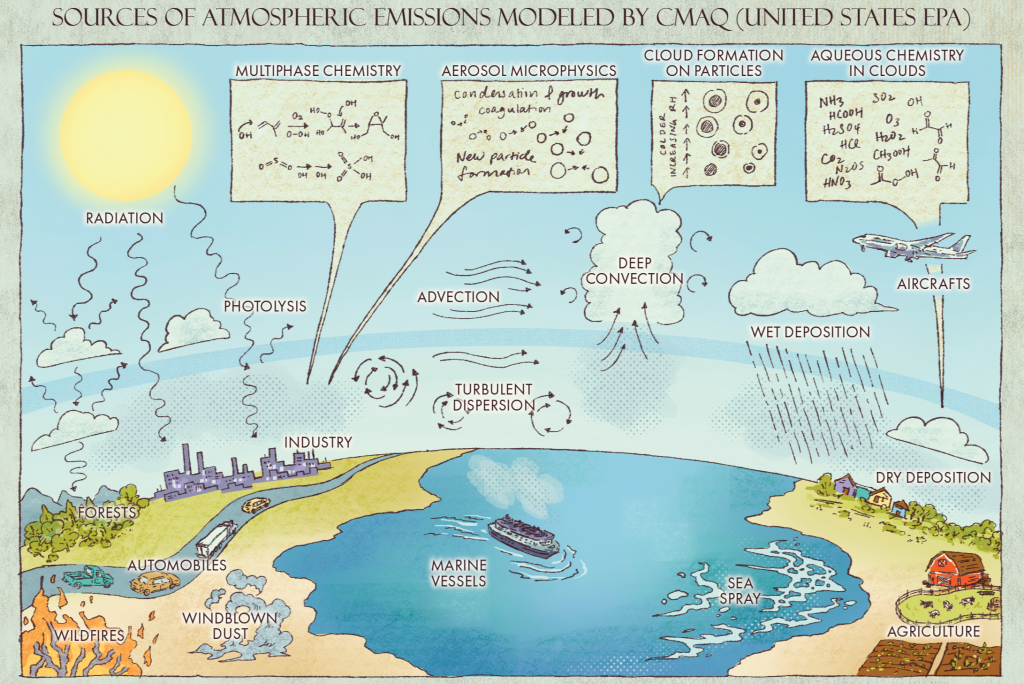Written by Pooja Nerkar
How advanced atmospheric modeling helps predict pollution, guide policy, and address environmental justice:
What happens when a region exceeds federal air pollution limits? One of the first steps is often to turn to a model—specifically, the Community Multiscale Air Quality Modeling System (CMAQ)—to simulate whether a proposed regulation will be enough to bring pollution back below the legal threshold.
CEE Ph.D. candidate Cam Phelan, a researcher in Assistant Professor Sunni Ivey’s Air Quality Modeling and Exposure Lab (AQMEL), describes CMAQ as “a bunch of tiny chemical reactors all flowing into and out of each other.” CMAQ breaks the atmosphere into a three-dimensional grid, modeling how pollutants move between cells and react chemically over time. These simulations must account for everything, from meteorology to emissions data, including the amount of pollution generated by each source on the ground.
It’s a monumental task. CMAQ bridges processes at the molecular scale, like chemical reactions between gases, with impacts at regional and national scales, where policymakers make decisions. Rooted in decades of scientific knowledge, CMAQ relies on first-principles modeling, meaning it simulates real-world physical processes using fundamental equations from chemistry and physics. Running even a single simulation can take weeks or months on supercomputers.

Not all models work this way. In contrast, researchers like Dr. Yuzhou Wang, a postdoctoral scholar in CEE Professor Joshua Apte’s lab, use empirical (data-driven) models that draw on massive datasets—such as satellite imagery and pollution measurements—to find patterns using machine learning. These models are faster and computationally cheaper. They’re great for identifying broad trends but lack the fine-grained physical accuracy of a system like CMAQ.
Still, even CMAQ needs to be constantly refined. Phelan’s research investigates how the model’s internal chemical assumptions affect its performance during temperature inversion events, when cooler air traps pollutants near the surface. In recent work, she tested four common chemical reaction schemes to see which most accurately predicted pollution levels under varying meteorological conditions. These kinds of studies—often highly technical and time-consuming—are essential to ensure that CMAQ remains reliable for real-world use.
What makes AQMEL unique is its ability to connect highly technical modeling work to policy outcomes. In 2023, Dr. Ivey and Dr. Wang co-authored a Science paper assessing the air quality impacts of the Justice40 initiative, a federal program that mandates 40% of climate and clean energy investments benefit disadvantaged communities. Their modeling showed the program reduced income-based disparities in air pollution, but did not eliminate racial disparities. Based on these findings, they recommended explicitly incorporating race as a factor in identifying priority communities.

On the left, sites A and B miss dangerous pollution in a densely populated area. On the right, adding site C reveals a hidden hotspot and improves coverage in high-risk communities. (Photo Credit: Eleanor Wang/Berkeley Science Review)
For Dr. Ivey, science and justice are inseparable. “People think that when you are seeking to address issues that have political implications, the science suffers,” she says. “But it doesn’t have to—if you maintain intellectual rigor.”
Read the full research study on Berkeley Science Review.

